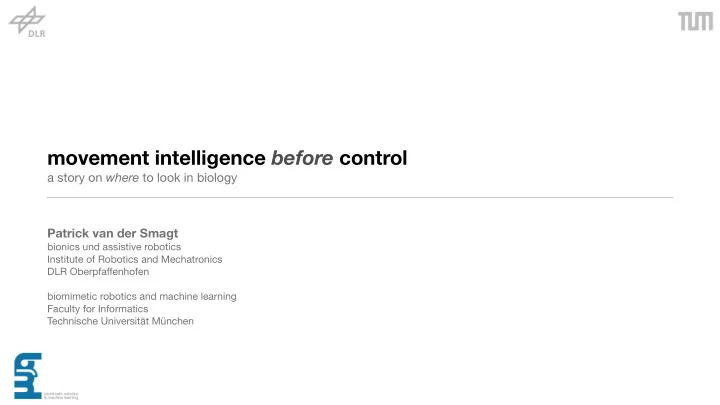

movement intelligence before control a story on where to look in biology Patrick van der Smagt bionics und assistive robotics Institute of Robotics and Mechatronics DLR Oberpfaffenhofen biomimetic robotics and machine learning Faculty for Informatics Technische Universität München
biology-inspired approach to robotics #1: movement intelligence is caused by superior control (“a robot with a biological brain”)
cerebellar models 1: the CMAC • Braitenberg (1961) • Marr (1969) • Albus (1971) • Albus (1975)
cerebellar models 2: the APG • Houk, Barto, Fagg (1989)
cerebellar models 3: the MPFIM • Wolpert, Kawato (1998, 2000) • Peters, van der Smagt (2001)
and more and more... • Smith‘s “Fairly Obvious Extension” (APG with vector-eligibility) • Schweighofer’s model (biologically inspired) • Hoff/Bekey Method (combined with spinal model) • CNS-BU Model (VOR) • Jabri et al (multi-layer Perceptron) • 2009: Jörntell, Nilsson (high-level model “LSAM”) • ...
from high-level (cerebellar) views • cerebellar lesions lead to ataxia , lack of order in movement---but movement is very possible • there are huge delays in the PNS which prevent fast feedback loops • recent theories see the cerebellum as a filter which smooths out cortical movement patterns with inertial feedback • ...somehow the controlled system must be smarter
biology-inspired approach to robotics #2: movement intelligence is present despite control (“a computer with a biological body”)
let’s see how nature did all of these step 1: let us try to understand the human body in its • kinematics • statics • dynamics step 2: let us then add intelligent control
1 kinematics problem: modelling the human hand Stillfried & van der Smagt, Proc. ICABB, 2010 Stillfried & & van der Smagt, J. Biomech, 2012 Synek & Stillfried, BioRob 2012
1 kinematics problem’: tracking MRI • repeatable position of rigid structure • high costs • costly post-processing • single-participant only • deformation not quantifiable
1 kinematics problem’: tracking tracking system • marker assignment done through unique markers • novel marker system • “highly accurate” • real-time • costly • skin deformations • non-portable Gierlach & Gustus & van der Smagt, BioRob 2012
1 kinematics problem’: tracking Kinect • uses particle filtering to do sequential Bayesian estimation • “marker-free” • real-time • portable • low accuracy Cordella & & van der Smagt, BioRob 2012
2 statics intrinsic stiffness of the human fingers ��������� ��������� ��������� ��� � � ������ � � ������ � � ������ ��� � ����� � ����� � ����� ��������������� ��� ��� ��� ��� � ��������� ��������� ������������ ��� � � ������ � � ������ ��� � ����� � ����� ��������������� ��� ��� ��� ��� � � �� �� �� � �� �� �� � �� �� �� patent pending ������� ������� ������� Höppner & & van der Smagt, IROS 2012
intrinsic stiffness of the human limbs 2 statics Höppner & & van der Smagt, Proc. ICABB, 2010
3 dynamics controlled stiffness of the human fingers Dominikus Gierlach
controlled stiffness of the human limbs (5D) 3 dynamics Lakatos & & van der Smagt, NCM 2012 Lakatos & & van der Smagt, ISER 2012
nature copes by reducing DoF to DoM • PCA of EMG of all grasps , separated by user Castellini & van der Smagt, ICAR 2011
nature copes by reducing DoF to DoM • PCA of EMG of all users , separated by grasp Castellini & van der Smagt, ICAR 2011
back to intelligent control fingers Bitzer & van der Smagt, 2006 Castellini & van der Smagt, 2009
back to intelligent control arm Vogel & & van der Smagt, IROS 2011
� � � � � � � � � the technology we built � � � � verbesserte Auflösung des EMG-Signals
credits students: the 2012 BRML group: Sebastián Aced (EMG electronics) Justin Bayer (time series learning) Constantin Böhm (arm impedance) Claudio Castellini (prosthetics) Daniele Casaburo (EMG source sep.) Nadine Fligge (grasping) Sarah Diot-Girard (deep networks) Agneta Gustus (hand dynamics) Dominikus Gierlach (spinal models) Hannes Höppner (arm dynamics) David Gonzalez (ultrasound) Dominik Lakatos (robot dynamics) Andreas Goss (finger model) Christian Osendorfer (deep nets) Barbara Hilsenbeck (finger EMG) Thomas Rückstiess (reinf. learn) Rachel Hornung (learning) Georg Stillfried (hand model) supported by: Daniela Korhammer (EEG) Michael Strohmayr (skin) The Hand Embodied (FP7) Marvin Ludersdorfer (feetback) Sebastian Urban (map learning) NinaPro (SNF) Stefan Zoell (design) Holger Urbanek (EMG) SPP autonomous learning (DFG) Jörn Vogel (BCI) STIFF (FP7) (past) VIACTORS (FP7) (past) SKILLS (FP6) (past) CoTeSys (DFG) (past) SENSOPAC (FP6) (past) NEUROBOTICS (FP6) (past)
Recommend
More recommend